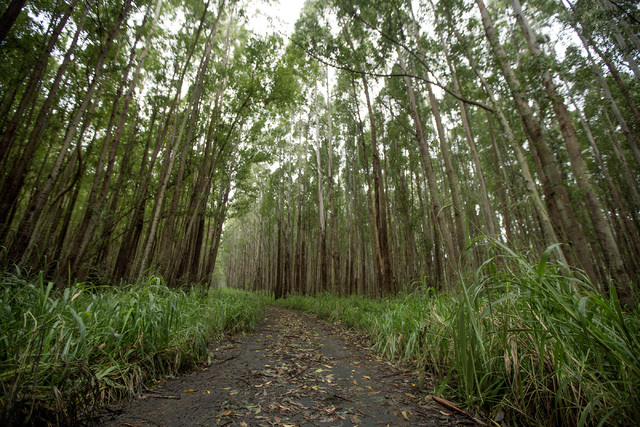The state Department of Land and Natural Resources is seeking public input regarding the latest overview of forest lands throughout the islands. ADVERTISING The state Department of Land and Natural Resources is seeking public input regarding the latest overview of
The state Department of Land and Natural Resources is seeking public input regarding the latest overview of forest lands throughout the islands.
Expanding on a document produced more than five years ago, the Hawaii Forest Action Plan pulls together assessments from state agencies, watershed and conservation groups, and other DLNR partners.
“I think it really does a good job of explaining the state of forest resources,” said Rob Hauff, forest health coordinator with the DLNR Division of Forestry and Wildlife.
About 40 percent of the state is covered by forest. Of that, 60 percent is considered productive and healthy, according to the draft. Hawaii Island has the most forest of any island because of its comparative size.
The first statewide forest assessment was completed in 2010 following a 2008 federal requirement established by that year’s Farm Bill.
“We definitely wanted to update it and improve upon it since then,” Hauff said.
The original plan and the updated version identify nine conservation and management issues for Hawaii forests: water quality and quantity; forest health (invasive species, insects and disease); wildfire; urban and community forestry; climate change and sea level rise; conservation of native biodiversity; hunting, nature-based recreation and tourism; forest products and carbon sequestration; and U.S. tropical island state and territorial issues.
The new version addresses concerns that were practically unknown in the state in 2010, such as rapid ohia death.
It also includes more data, including new wildfire numbers provided by the University of Hawaii indicating that the percentage of land area burned in Hawaii is greater than the national average and can surpass the percentage burned in Western states.
Wildfire is expected to become more of a concern statewide in the face of climate change, as are the impacts and frequencies of severe weather events such as hurricanes.
Other climate change threats listed include an increase in frequency and severity of weather events such as hurricanes, and increases in flash flooding and soil damage.
The report also notes that warming temperatures at high elevation could make native forests more vulnerable to invasive species, noting “the climactic range of certain pests (is) still limited to lower elevations.”
Mosquitoes that transmit disease to native birds are cited as the primary example of this phenomenon.
Even as the DOFAW document lays out each of the potential threats to Hawaii’s forests in light of climate change, it addresses the forests’ potential to help mitigate these events.
Tropical forests can store more carbon dioxide than temperate forests. The document suggests developing forestry strategies to maximize that carbon storage, which could then be shared with other tropical locations.
The report also discusses reforestation and the potential of selling carbon credits, as well as the growing biomass market that could use trees to make biofuel. Invasive trees such as albizia are listed as being particularly useful for this end.
Export market opportunities “appear to exist” for native species such as sandalwood and koa as well as non-natives such as eucalyptus. Eucalyptus lumber is sold in Indonesia and the Pacific Northwest.
Forestry strategies of any sort involve the coordination and cooperation of the dozens of public and private groups that are responsible for land stewardship.
“The way our lands are divided up by ownership is kind of a big quilt,” Hauff said. “So, when you can get those landowners together to combine resources and manage them together, it’s much more effective.”
To view the draft plan, visit https://dlnr.hawaii.gov/forestry/files/2016/12/Forest_Action_Plan_Draft_2016.pdf.
Comments will be accepted through Dec. 14. Written comments can be emailed to Robert.D.Hauff@hawaii.gov or mailed to Forest Action Plan, Division of Forestry and Wildlife, Room 325, 1151 Punchbowl St., Honolulu, HI 96813.
Email Ivy Ashe at iashe@hawaiitribune-herald.com.



